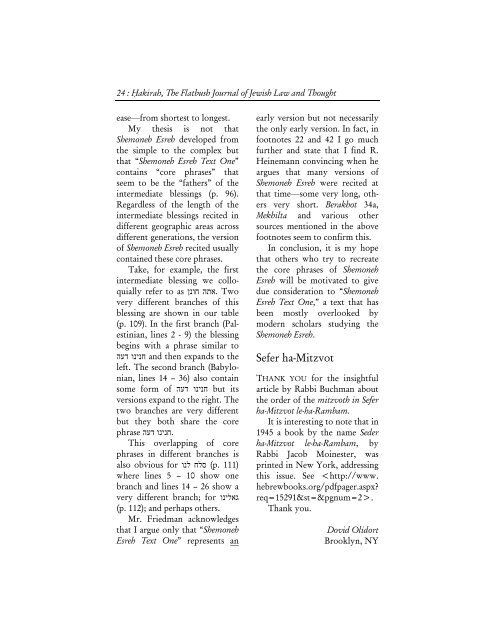the letter. - Hakirah.org
the letter. - Hakirah.org
the letter. - Hakirah.org
You also want an ePaper? Increase the reach of your titles
YUMPU automatically turns print PDFs into web optimized ePapers that Google loves.
24 : Hạkirah, The Flatbush Journal of Jewish Law and Thought<br />
ease—from shortest to longest.<br />
My <strong>the</strong>sis is not that<br />
Shemoneh Esreh developed from<br />
<strong>the</strong> simple to <strong>the</strong> complex but<br />
that “Shemoneh Esreh Text One”<br />
contains “core phrases” that<br />
seem to be <strong>the</strong> “fa<strong>the</strong>rs” of <strong>the</strong><br />
intermediate blessings (p. 96).<br />
Regardless of <strong>the</strong> length of <strong>the</strong><br />
intermediate blessings recited in<br />
different geographic areas across<br />
different generations, <strong>the</strong> version<br />
of Shemoneh Esreh recited usually<br />
contained <strong>the</strong>se core phrases.<br />
Take, for example, <strong>the</strong> first<br />
intermediate blessing we colloquially<br />
refer to as חונן .אתה Two<br />
very different branches of this<br />
blessing are shown in our table<br />
(p. 109). In <strong>the</strong> first branch (Palestinian,<br />
lines 2 - 9) <strong>the</strong> blessing<br />
begins with a phrase similar to<br />
and <strong>the</strong>n expands to <strong>the</strong> חנינו דעה<br />
left. The second branch (Babylonian,<br />
lines 14 – 36) also contain<br />
some form of חנינו דעה but its<br />
versions expand to <strong>the</strong> right. The<br />
two branches are very different<br />
but <strong>the</strong>y both share <strong>the</strong> core<br />
.חנינו דעה phrase<br />
This overlapping of core<br />
phrases in different branches is<br />
also obvious for סלח לנו (p. 111)<br />
where lines 5 – 10 show one<br />
branch and lines 14 – 26 show a<br />
גאלינו very different branch; for<br />
(p. 112); and perhaps o<strong>the</strong>rs.<br />
Mr. Friedman acknowledges<br />
that I argue only that “Shemoneh<br />
Esreh Text One” represents an<br />
early version but not necessarily<br />
<strong>the</strong> only early version. In fact, in<br />
footnotes 22 and 42 I go much<br />
fur<strong>the</strong>r and state that I find R.<br />
Heinemann convincing when he<br />
argues that many versions of<br />
Shemoneh Esreh were recited at<br />
that time—some very long, o<strong>the</strong>rs<br />
very short. Berakhot 34a,<br />
Mekhilta and various o<strong>the</strong>r<br />
sources mentioned in <strong>the</strong> above<br />
footnotes seem to confirm this.<br />
In conclusion, it is my hope<br />
that o<strong>the</strong>rs who try to recreate<br />
<strong>the</strong> core phrases of Shemoneh<br />
Esreh will be motivated to give<br />
due consideration to “Shemoneh<br />
Esreh Text One,” a text that has<br />
been mostly overlooked by<br />
modern scholars studying <strong>the</strong><br />
Shemoneh Esreh.<br />
Sefer ha-Mitzvot<br />
THANK YOU for <strong>the</strong> insightful<br />
article by Rabbi Buchman about<br />
<strong>the</strong> order of <strong>the</strong> mitzvoth in Sefer<br />
ha-Mitzvot le-ha-Rambam.<br />
It is interesting to note that in<br />
1945 a book by <strong>the</strong> name Seder<br />
ha-Mitzvot le-ha-Rambam, by<br />
Rabbi Jacob Moinester, was<br />
printed in New York, addressing<br />
this issue. See .<br />
Thank you.<br />
Dovid Olidort<br />
Brooklyn, NY
















